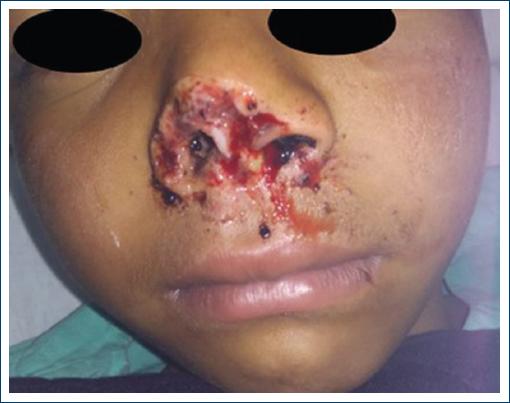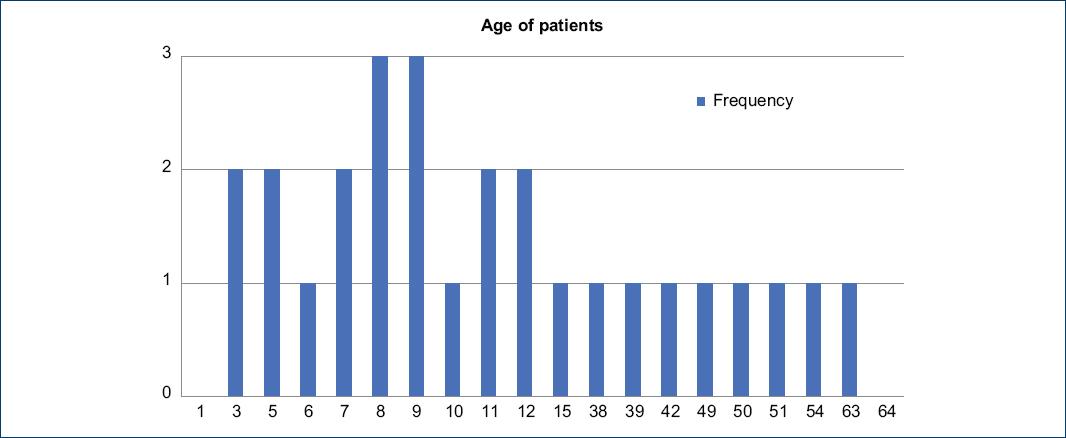Introduction
The data obtained from the American Society of Plastic Surgeons show that about 28,000 patients require management by plastic and reconstructive surgery annually for dog bites, to this we have to add high management costs and the sequelae and complications of the bite1. In Mexico it is estimated that about 90,000 people suffer dog bites each year2. The real incidence of dog bites is underestimated. Studies have found that only a third of dog bite victims go to the doctor3. It is more common for children to receive medical attention for dog bites than adults4. It is estimated that developing countries have a higher incidence of dog bites than developed countries, in addition to the relative lesser access to an adequate health system5. With this article we want to present the epidemiology of this phenomenon in our environment, to describe the therapeutic options, the type of proceeding to which our patients were subjected and the experience in the management in our hospital of this group of patients.
This pathology has a great impact on a social and economic level in this age group, since the highest incidence is found in patients aged 5-9 years. These patients present certain characteristics that make them not only more frequent, but also more serious, such as the lack of motor skills to protect the face. By requiring specialized management, patients often require management in second or third level units, which increases the costs of care and transfers.
Methods
A retrospective study was carried out where records were obtained of all the patients who had dog bite wounds in the plastic and reconstructive surgery service at the General Hospital of Zacatecas “Luz González Cosío” in the period between March 2018 and February 2021 Demographic variables of age and sex were collected. The variables related to the bite were anatomical location, the body was divided into 6 parts to determine the wound site: face, skull, neck, trunk, upper limb and lower limb. Data were obtained on the therapy used and surgical management used (cleaning, surgical debridement and primary closure, specialized reconstructive process). The days of hospital stay were also collected.
Medical and surgical management were carried out taking into account the severity of the pathology, using more invasive procedures in these situations. The initial medical management was carried out with antibiotics, described in the respective table. In the cases of surgical cleaning, this was carried out with hydrogen peroxide and povidone iodine, rinsing with injectable water. In the case of surgical debridement, this was performed with the main focus on eliminating necrotic edges and areas with data of infection, removing them completely. Primary closure was chosen in patients with no evidence of infection or lesions suggestive of it. As for the specialized surgical treatment, it was carried out in the most complicated lesions, which compromised the functionality of the patient.
Results
The analysis of the database revealed that between March 2018 and February 2021 a total number of 27 patients between the ages of 3 and 63 years were found (Fig. 1), they were treated in the hospital for dog bite injuries. Demographic characteristics of the patients are shown in Table 1. From 27 patients, 19 patients (70.3%) were under 15 years of age, the average age was 20.1 years, a greater number of male patients was found than female patients, 17 (63%) versus 10 (27%), respectively with a 1.7: 1 male female ratio. The most frequent location was the face and skull in 12 patients (44.4%), of which 11 were under 15 years of age, followed by the lower extremity in 10 patients (37%), of which 5 were under 15 years and 5 were older. (15 years). The type of treatment used in most cases was cleaning, surgical debridement and primary closure in 22 cases (81.4%), in 5 cases a specialized reconstructive process was required (18.6%). 81.4% of the patients required a single intervention and 18.6% 2 or 3 interventions. There was 1 case of tissue loss in the nasal region (Fig. 2), this was managed by paramedian frontal flap (Fig. 3). Hospitalization was required in 5 cases, with an average in-hospital stay of 4 days. The patients who required longer hospitalization were those with more complex injuries. The complexity of the lesions was managed according to the WHO criteria for dog bites (Table 2). In all cases, antibiotic treatment (Amoxicillin/Clavulanic acid) was administered with an average duration from between 1 week to 10 days. Amoxicillin/clavulanic acid is the empirical treatment of choice for the management and prophylaxis of dog and cat bites. There are alternative regimens with ceftriaxone and doxycycline, however, these were not used in the patients studied. In our study we did not find any case of infection. The application of vaccines was carried out according to the WHO guidelines, depending on the degree of the lesion (Table 3). No mortality was reported.
Table 1 Demographic information, characteristics of the wound and management
| Grooming, surgical debridement, and primary closure | Specialized reconstructive process | Total | |
|---|---|---|---|
| Gender | |||
| Male | 12 | 5 | 17 |
| Female | 10 | 10 | |
| Anatomical location | |||
| Face | 3 | 5 | 8 |
| Skull | 4 | 4 | |
| Neck | 2 | 2 | |
| Trunk | 2 | 2 | |
| Superior limbs | 4 | 4 | |
| Lower limbs | 10 | 10 | |
| Antibiotic nanagament Amoxacilin/clavulanic acid | 22 | 5 | 27 |

Figure 2 Representative clinical case. A 5-year-old male patient with a dog bite wound in the region of the right nasal wing with loss of tissue.

Figure 3 A-B: paramedian frontal flap. trans-surgical, C: flap rotation, D: evolution 10 days after surgery.
Discussion
Evidence shows that the age group where the most dog bites occur is in children under 15 years of age and in males, as is also shown in most studies6,7. The high prevalence of dog bites in children is attributed to short stature and increased exposure to dogs, as well as the lower development of the psychomotor system, necessary for the protection of vital areas8. In most cases the attack involves a family dog usually without the presence of an adult, which also corresponds to that reported in the literature9. A complete physical examination should be carried out, with examination of the wound preferably under anesthesia, especially in children due to the possibility of associated injuries, airway, arteries, eyes, cervical spine and skull fractures10. In the study we also found that if the primary closure of dog bites is safe, there is little risk of presenting infections and they provide better cosmetic results, as described in the literature11-12. Dog bites continue to play an important role among the pathologies of this age group and, taking into account that they are preventable, we consider it vital to make the population aware of risk situations, the most possible mechanisms of injury and the ages that have a higher risk.
We present the care diagram used in the plastic and reconstructive surgery service of the General Hospital of Zacatecas “Luz González Cosío” (Fig. 4).
Conclusion
Dog bites continue to play an important role and are considered preventable. Previously there was the idea that dog bite wounds were not sutured because they were considered contaminated with a tendency to infection. The findings suggest that the primary closure of dog bite wounds is safe, when properly managed (surgical grooming, edge debridement, and antibiotic prophylaxis), as long as it is performed within the first hours of the lesion’s evolution. Plastic surgery assessment should always be performed to assess the complexity of the wounds on an individual basis.











 nueva página del texto (beta)
nueva página del texto (beta)




